You are here: » Christianity in View » Introduction to Protestantism » The Reformers
 Luther, Calvin and Zwingli
Luther, Calvin and Zwingli
These are the three significant figures of the reformation:
| Martin Luther | John Calvin | Ulrich Zwingli |
 Martin Luther (1483-1546):
Martin Luther (1483-1546):
Martin Luther was born on 10 November 1483 in the Saxon mining town of Eisleben, Germany to Hans and Magarethe Luther. He was baptised the following day, the feast day of St. Martin (of Tours) and was thus named. Hans Luther was ambitious for his son and wanted him to pursue a career in law, and in agreement, Luther entered the legal faculty of the University of Erfurt in 1501. He received his Master’s degree there in 1505.

The Parents of Martin Luther: Hans and Margaret
Things changed dramatically when on 2 July 1505, Luther was caught in a violent thunderstorm. On being struck by a bolt of lightning, Luther cried out for help to Saint Anne, the patron saint of Miners, saying: “I will become a monk!”. A few weeks later, Luther made good his promise and entered the Augustinian monastery at Erfurt, a decision that did not come with his Father’s approval.
Luther embraced the monastic life, with long hours of study, prayer and fasting. He took his monastic vows in 1506 and was ordained a priest in 1507. At this time, Luther also was studying theology at the University of Wittenburg and in 1512 he received his doctorate. He then proceeded to lecture on several biblical books, including the Psalms and Paul’s letter to the Romans.
Luther’s intense study of the Bible was partly influenced by the Humanist movement of the day. This called for a ‘return to the sources’ (Ad fontes) of classical Greek and Latin literature. Luther began to see how this might be applied in a biblical capacity – the need to examine the scriptures from the original Hebrew and Greek texts and discover their true meaning.

Martin Luther (1483-1546)
Despite all the hard work and effort, Luther struggled with the weight of his own sinfulness. He wrote:
Though I lived as a monk without reproach, I felt that I was a sinner before God with an extremely disturbed conscience. I could not believe that he was placated by my satisfaction. I did not love, yes, I hated the righteous God who punishes sinners, and secretly, if not blasphemously, certainly murmuring greatly, I was angry with God.
However at some point between 1515-8, there came a spiritual breakthrough: Whilst studying Romans 1:17, Luther was led to the conclusion that our standing before God is dependent on our faith alone, and not through any works or goodness within us. This has been called Luther’s Turmerlebnis (Tower Experience).
“For therein is the righteousness of God revealed from faith to faith: as it is written. The just shall live by faith.”
Romans 1:17 (KJV)
Luther explained his ‘discovery’ in this way:
At last, by the mercy of God, meditating day and night, I gave heed to the context of the words, namely, ‘In it the righteousness of God is revealed’, as it is written, ‘He who through faith is righteous shall live’. There I began to understand that the righteousness of God is that by which the righteous lives but a gift of God, namely by faith. … Here I felt that I was altogether born again and had entered paradise itself through open gates.
The church of the day was very much concerned with the doctrine of Indulgences, that is, reducing or removing entirely the temporal penalty for sin, whether in this life or in Purgatory. The Pope, by virtue of his position as God’s representative on earth, was seen as having the power to grant an indulgence. The system was abused, most notably by Johan Tetzel, a Monk who was charged by the Pope to sell indulgences in Germany. The monies raised were, amongst other things, being used partly to fund the rebuilding of St. Peter’s Basilica in Rome.
As soon as the coin in the coffer rings, the soul from purgatory springs.
On seeing the corruption before him, Luther felt forced to take action. What happened next been an issue of debate, but the traditional account is that on 31 October 1517, Luther posted up a series of 95 discussion points (known as ‘Theses’) on the door of the castle church at Wittenburg. To present discussion points in this way was an accepted practice of the time, but Luther did not (and could not) anticipate the reaction to what he had written.
![]() View or download the 95 Theses in PDF format.
View or download the 95 Theses in PDF format.
The 95 theses were printed and circulated around Germany and soon reached other parts of Europe. At this point, Pope Leo X took notice of developments and Luther was summoned to appear before him in 1518. After a change of heart, the Pope instead sent Cardinal Thomas Cajetan to meet with Luther and demand that he recant his views. Luther refused and in a public debate at Leipzig in 1519, stated publicly that he could no longer accept papal supremacy.
Pope Leo X issued a declaration (known as a ‘Bull’) in June 1520. Exsurge Domine demanded that Luther retract 41 of his 95 theses to avoid the possible threat of excommunication from the church. Luther decided to publicly burn the Bull in December 1520 and was then issued with another Bull in January 1521 (Decet Romanum Pontificem), bringing the excommunication into force.
In August 1520 Luther published his work To the Christian Nobility of the German Nation, which outlined his plans for the reform of the church in Germany. He also gave an exposition of his theology (with a particular emphasis on the Sacraments *) in the Prelude on the Babylonian Captivity of the Church, and in Freedom of a Christian, explained his emphasis on salvation through faith in Christ.
* Having originally allowed Penance, Luther eventually settled on only two sacraments: Baptism and Holy Communion.
By now, Luther’s language had become more and more strident in denouncing the authority of the Roman Catholic church, including frequent references to the Pope as the antichrist.
In January 1521, the Emperor Charles V summoned Luther to appear at a Diet (assembly) in Worms, Germany. He was granted safe conduct there by Frederick the Wise, prince of Saxony. Arriving there in April 1521, Luther was given one more chance to recant.
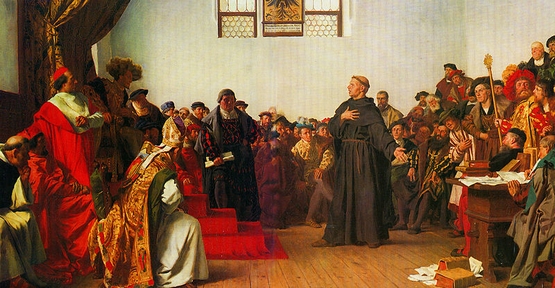
Luther at the Diet of Worms (1521)
However, when asked to do so, Luther replied:
Unless I am convicted by Scripture and plain reason, I do not accept the authority of popes and councils, for they have contradicted each other, my conscience is captive to the Word of God. I cannot and will not recant anything, for to go against conscience is neither right nor safe.
With these words the breach with the Roman Catholic church became permanent, an edict was issued declaring Luther a heretic, and his writings were banned. Luther fled before the Diet ended and decided to hide in the Wartburg Castle at Eisenach. He spent a year there working on a translation of the bible into German. In 1522 Luther returned to Wittenburg, where he carried out several reforms. He was assisted by his colleague Philipp Melanchthon (1497-1560), who wrote a presentation of Protestant Theology known as Loci Communes (‘Common Places’).
Luther’s posting of the 95 Theses propelled him into the spotlight in a way that even he could not have imagined. Printed, as opposed to verbal, ideas could travel fast and in a environment when many were desperate for change, a form of reformation was indeed inevitable. Luther’s strong personality, coupled with the fact that he had tapped into an underlying nationalism in Germany against papal interference made for a powerful stimulus for reform.
Once reform had started, the course it was to take was less inevitable. To many, the Papacy had been slow to respond, firstly to the demands for reform and secondly, once the Reformation had begun, to provide a robust response. The Catholic church did respond to the Reformation with it’s own counter-reformation, starting from the Council of Trent (1545-1563), which firmly rejected many of the emerging doctrines of the reformers but did address some of their complaints. Although Luther had initiated the Reformation, he could not control it and precisely how reform was to take place and what was to be reformed would be keenly debated by the Reformers themselves in the years following 1517.
Luther did not wish to leave the Catholic church, rather his initial aim was to reform it. Yet, if reform was being resisted or delayed, separation would be the result, as he argued that the Reformation would restore to the church a biblically correct doctrine of salvation.
The Renaissance, with its new ideas and models of learning played a large part in the demands for reform. A growing sense of individualism against clericalism and the right for any individual to read and understand the scriptures for themselves against the control of the church was again a powerful stimulus. Luther remarked: “a simple layman armed with Scripture is greater than the mightiest pope without it.”
German peasantry launched a full scale revolt against the nobility in 1524, hoping to gain support from Luther. However, Luther chose not to support them, partly because of the brutality of the revolt and also because he relied on the support and protection of the nobility. In fact, Luther lost credibility in advocating a ruthless suppression to end the uprising.
In 1525, Luther married Katharina von Bora (1499-1552), a former nun. His decision to do so set a seal of approval on clerical marriage. The marriage itself resulted in six children.
My Katie is in all things so obliging and pleasing to me that I would not exchange my poverty for the riches of Croesus.
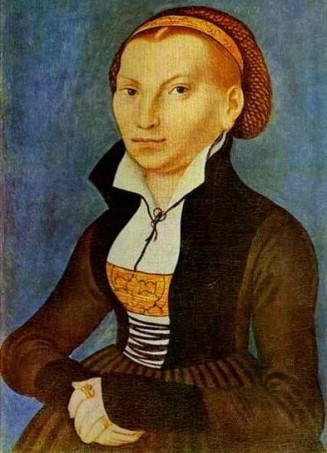
Katharina Von Bora
In 1529 Luther met with the Swiss reformer Ulrich Zwingli at Marburg, in order to attempt an agreement on theological matters and thus unify Protestant theology. Of the fifteen points presented, all were agreed bar one: the doctrine of the presence of Christ in the Eucharist. Luther argued for a real bodily presence, but Zwingli disagreed, arguing that the bread and the wine were only symbols of Christ’s body and blood.
The year 1530 saw the publication of the Augsburg Confession, a statement of Lutheran doctrine. The confession was mostly edited by Philipp Melanchthon.
Apart from his theological writings, Luther wrote several anti-semitic works which have stimulated much discussion among historians. Modern Lutherans have rejected his views, which to a modern ear sound harsh and unforgiving.
Suffering with ill health for many years, Luther eventually died on 18 February 1546 at Eisleben and was buried in Wittenburg. His last words include a striking statement written in both German and Latin:
Wir sein pettler, Hoc est verum. (We are Beggars, This is true).
 The Lutheran Seal
The Lutheran Seal
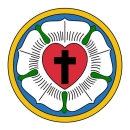
In a letter of 1530 to a friend, Luther explained the meaning of the seal thus:
The first thing expressed in my seal is a cross, black, within the heart, to put me in mind that faith in Christ crucified saves us. “For with the heart man believeth unto righteousness.”
Now, although the cross is black, mortified, and intended to cause pain, yet it does not change the colour of the heart, does not destroy nature – i.e., does not kill, but keeps alive. “For the just shall live by faith,” – by faith in the Saviour.
But this heart is fixed upon the centre of a white rose, to show that faith causes joy, consolation and peace. The rose is white, not red, because white is the ideal colour of all angels and blessed spirits.
This rose, moreover, is fixed in a sky-coloured ground, to denote that such joy of faith in the spirit is but an earnest and beginning of heavenly joy to come, as anticipated and held by hope, though not yet revealed.
And around this ground base is a golden ring, to signify that such bliss in heaven is endless, and more precious than all joys and treasures, since gold is the best and most precious metal. Christ, our dear Lord, He will give grace unto eternal life.
 John Calvin (1509-1564):
John Calvin (1509-1564):
John Calvin was born as Jean Chauvin in Noyon, France. Noyon is in the French region of Picardy and lies about 65 miles North East of Paris.
Calvin (the anglicised form of his name), entered the University of Paris in 1523 to study law and received his doctorate in 1532. Whilst in Paris, he studied the writings of Martin Luther and became convinced of the need for reform. Opposition led to him seeking refuge elsewhere and in 1536, en route to Basel, he stayed in Geneva. He met William Farel (1489-1565) who persuaded a reluctant Calvin to remain and help organise the reformation there.
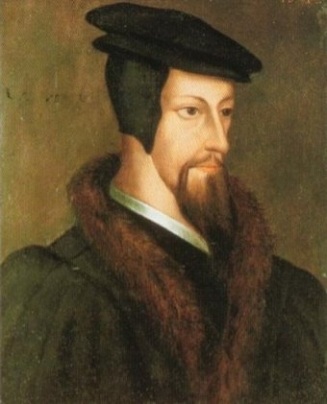
John Calvin (1509-1564)
Also in 1536, Calvin published (in Latin) the first edition of his magnum opus on Christian theology: Institutes of the Christian Religion, with the final edition being published in 1559. The Institutes were later translated into French, English and several other languages and form the basis for Calvinist theology to this day.
With the aid of William Farel, Calvin sought to change the political and spiritual life of the city. A confession of faith was drawn up, to which all Genevans were expected to adhere. Calvin also sought powers of excommunication, which led to much resistance. As a result, Calvin fled to Strasbourg where he led a church there. He also decided to marry in 1539.
In 1541, Calvin returned to Geneva. He decided to create a theocracy, a ‘City of God’, basing it on the Old Testament model. The government of Geneva was placed in the hands of Pastors, Elders and Deacons. He also set up the Consistory (A church court), to enforce discipline. Enforcement could be harsh, with floggings and other punishments used. Most notable was the case of Michael Servetus, who was imprisoned by the Roman Catholic authorities on charges of heresy (Servetus had denied the Trinity and also the true divinity of Christ). Servetus escaped and fled to Geneva, but was arrested and burnt at the stake. Calvin had personally approved of the burning.
Perhaps the most important aspect of Calvin’s theology was his analysis of the doctrine of Predestination. Calvin argued that salvation was something not freely chosen, rather individuals were elected to it by God. These individuals (the elect ) are known only to God.
[Predestination is] the eternal decree of God, by which he determined with himself whatever he wished to happen with regard to every man. Not all are created on equal terms, but some are preordained to eternal life, others to eternal damnation; and, accordingly, as each has been created for one or other of these ends, we say that he has been predestined to life or to death.”
Calvin died on 27 May 1564 at Geneva and was buried in a cemetery there. His influence led to the development of the Reformed churches and the famous Five points of Calvinism.
 Ulrich Zwingli (1484-1531):
Ulrich Zwingli (1484-1531):
Ulrich (or Huldrych) Zwingli was born in the Swiss canton of St. Gallen in 1484. He studied initially at Vienna, before moving to Basel and being awarded a degree in 1504. Zwingli was ordained a priest in 1506 and spent ten years pastoring in Glarus, another Swiss canton. As with Luther, Zwingli came into contact with humanist influences (including the writings of Erasmus) and devoted himself to studying Hebrew and Greek. His growing reputation as a fine speaker and teacher led eventually to his appointment as priest in Zurich.
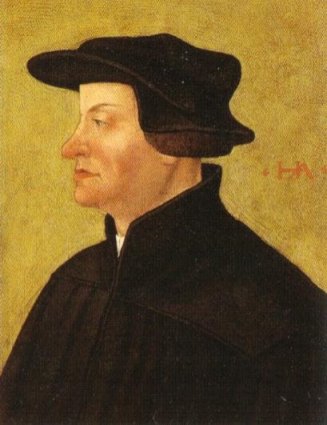
Ulrich Zwingli (1484-1531)
Gradually Zwingli began to oppose the teachings of the Roman Catholic Church, having come into contact with the writings of Martin Luther.
He began to attack the doctrines of purgatory, prayers to saints and significantly the doctrine of the real presence of Christ in the Eucharist.
The Zwinglian view of the presence of Christ is commonly called ‘Memorialism’ – the idea that the bread and the wine are merely symbols of Christ’s body and blood. This is in contrast to Luther’s view that the body and blood of Christ are truly present in the bread and the wine and the view of John Calvin, that Christ is spiritually present.
Pope Adrian VI took notice of the situation and requested that the council in Zurich discipline Zwingli and declare him a heretic. In 1523, a public hearing was held there. Zwingli defended himself and his defence proved persuasive – the council backed him and thus endorsed the reformation.
A group calling themselves the Anabaptists (Re-baptizers) opposed the policy of infant baptism and refused to join Zwingli’s group. They were ruthlessly silenced and left Zurich in 1526.
Gradually Zwingli tried to spread reformation ideas across all of the Swiss cantons, but this met with mixed success. Eventually civil war broke out and in 1531, Zwingli was killed in battle while defending Zurich.
For God’s sake, do not put yourself at odds with the Word of God. For truly it will persist as surely as the Rhine follows its course. One can perhaps dam it up for awhile, but it is impossible to stop it.
Ulrich Zwingli
More information:
Here is a selected series of links that will give more information:
Martin Luther | John Calvin | Ulrich Zwingli |
 Wise words:
Wise words:
“Wherever we find the Word of God surely preached and heard, and the sacraments administered according to the institution of Christ, there, it is not to be doubted, is a church of God. ”
John Calvin (1509-1564)